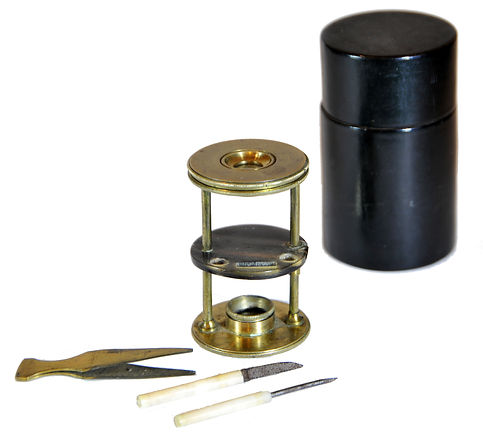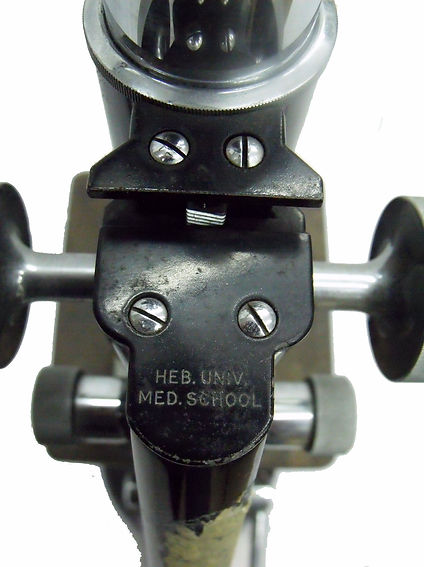

Withering-type botanical microscope, 1780
The “Withering-type Microscope” is named for its inventor, Dr. William Withering (1741-1799), an English physician and botanist who graduated with a degree in medicine 1766 in Edinburgh. Inspired by the taxonomical work and systematic classification of Carl Linnæus (1707-1778), Withering (1776) applied the Linnaean taxonomical system of classification to British plants in a seminal, two volume work, A Botanical arrangement of all the vegetables naturally growing in the British Isles. The earliest reference to a small botanical microscope of Withering’s design appeared in the first edition of this book. There, Withering indicated this microscope was developed for field dissections of flowers and other plant parts. While there is no surviving example of this exact design, close relatives of this type do exist, made either completely of brass or of ivory with brass pillars. Ivory models can be tentatively dated to 1776-1785, as by 1787 a newer model with a hollowed stage in an all-brass configuration already predominated. In turn, it was preceded by the brief appearance of a transitional brass model but with solid stage of ivory or horn (seen here). This version is extremely rare and must have been produced in very small numbers. By 1787 all these varieties were not recorded anymore in the literature.

Withering-type botanical microscope, 1780
The “Withering-type Microscope” is named for its inventor, Dr. William Withering (1741-1799), an English physician and botanist who graduated with a degree in medicine 1766 in Edinburgh. Inspired by the taxonomical work and systematic classification of Carl Linnæus (1707-1778), Withering (1776) applied the Linnaean taxonomical system of classification to British plants in a seminal, two volume work, A Botanical arrangement of all the vegetables naturally growing in the British Isles. The earliest reference to a small botanical microscope of Withering’s design appeared in the first edition of this book. There, Withering indicated this microscope was developed for field dissections of flowers and other plant parts. While there is no surviving example of this exact design, close relatives of this type do exist, made either completely of brass or of ivory with brass pillars. Ivory models can be tentatively dated to 1776-1785, as by 1787 a newer model with a hollowed stage in an all-brass configuration already predominated. In turn, it was preceded by the brief appearance of a transitional brass model but with solid stage of ivory or horn (seen here). This version is extremely rare and must have been produced in very small numbers. By 1787 all these varieties were not recorded anymore in the literature.
References: SML: A242712; Goren 2014.
References: SML: A242712; Goren 2014.
Prof. Yuval Goren's Collection of the History of the Microscope
Early Microscopes in Israeli Universities



Carl Zeiss “Jacob” 1927, one of the first set of microscopes acquired by the Hebrew University in Jerusalem
This instrument can stand as an archetype of the conventional research microscope of the 1920s-30s. It was manufactured by Carl Zeiss of Jena in 1927. As is typical of early 20th century stands, the shoe and the limb are made of black Japanned iron or brass while the tube is of lacquered brass. Yet the coarse and fine focusing wheels, the condenser and the nosepiece turret already herald the standard forms that will continue well into the second half of the 20th century and in simple student microscopes – till today.
This specimen is one of the first set of microscopes purchased by the Hebrew University of Jerusalem for the Medical School after the opening of the university on April 1st, 1925.

Spencer (American Optical), 1948, Unused Research Microscope of the Hebrew University in Jerusalem
To be added.
Charles Achilles Spencer was the first American to produce microscopes in the United States, published his first catalog in 1838. In 1865, he founded CA Spencer & Sons in Constanta, New York, but moved the business to Geneva, New York in 1873, To produce microscopes for Geneva Optical Co. these instruments were marked "CA. Spencer and Sons for Optical Geneva. After the death of Charles Spencer in 1881, the business was run by his son Herbert, who moved the company to Buffalo, New York in 1890. From 1890 to 1895, the company became known as Spencer and Smith. Though there were over twenty American microscope makers in the late 19th century, only Spencer and Bausch & Lomb continued to produce microscopes into the 20th century. By 1935, demand for Spencer’s microscopes had grown and the company was purchased by American Optical in the same year. The company remained in Buffalo, New York, and in 1938 the first catalog listing for the American Optical microscopes was published. By 1900, Spencer had produced about 8,000 instruments; But serial numbers began to be implemented by the Spencer Company only around the turn of the century, and the first serial number appears to have been 1001. In 1945 the name was changed to American Optical Scientific Division.
The microscope seen here is the research model binocular microscope of the 1940s.



Watson & Sons “Service II” 1952, of the first generation of microscopes acquired by the Hadassah Medical School
This fine instrument, typical of the 1950s design, was acquired by the Hadassah University Medical Center for training students in histology. Apart of bearing a Hebrew University inventory number, the cover plate on the upper part of the limb is engraved: Heb. Univ. Med. School.
The Faculty of Medicine was planned to be established still in the late 1940s, but the events of Israel’s Independence War, especially the attack in Jerusalem on the convoy of armored vehicles in April 13th 1948, where 78 staff members and professors from the Hadassah Medical Center were killed, postponed the opening of the School of Medicine till 1949. Yet the first registration of regular students to the full academic program began only in 1952. This microscope was purchased during the same year for training these students in histology.



Wild M-11, 1954, one of the first ten microscopes acquired by Tel Aviv University
This specimen is one of the first ten microscopes purchased in 1954 by the Academic Institute of Natural Sciences, later to become Tel Aviv University. After the establishment of the State of Israel, Haim Levanon, Mayor of Tel Aviv till 1959, actively campaigned for the founding in Tel Aviv of a second Israeli university. Despite much objection, the idea was eventually realized on August 16, 1953, when the Municipal Council of Tel Aviv-Jaffa decided to transform the Biological-Pedagogical Institute into the Academic Institute of Natural Sciences, which would form the core of a future university. It was located at the Abu Kabir campus in southern Tel Aviv, and had 24 students in its first year. A set of ten Wild M11 microscopes including this one was acquired, to form the core of the scientific training of these students.
Another item of the same lot of ten is on display in a special case with a commemorative brass plate in the lobby of the Senate Building.


The microscopes of Alec Marcus
The microscopes seen here belonged to Alec Marcus (1917-2010). Alec was born in Johannesburg, Gauteng, South Africa, son of Meisha Gedalia Marcus and Reizel Marcus and husband of Jaffa Marcus (1924-1994). He was a member of the South African Gemology Society. The vast collection he brought with him to Jerusalem from South Africa was purchased by the Hebrew University of Jerusalem for their Minerals and Petrology Collection. This collection is outstanding for its emphasis on South African ore and Precambrian rocks including a selection of copper minerals from the famous Tsumeb mine in Namibia, where flooding has totally destroyed access to the underground deposits. Alec even worked as the collection's curator for 10 years. Alec donated most of his collection to the Department of Geology at the Hebrew University in memory of his dear son, the late David Marcus, who died of an illness at the age of 59.
Alec taught stone polishing at the Bezalel School of Art in Jerusalem. At the age of 85 he learned painting and created a large number of paintings.
I bought these two microscopes, which he brought with him from South Africa, from his son Ronnie in 2015.

Alec Marcus (1917-2010)
Cooke, Troughton & Simms, Ltd., York, "The Ore Microscope", 1954

The Cooke, Troughton & Simms (CTS) "Ore Microscope" was introduced in 1952 to allow both the examination of metallographical and opaque samples in reflected polarized light, as well as for mineral sections studied under transmitted light. By the post-WWII years, the introduction of graded diamond abrasives has overcome most of the difficulties in polishing mineral samples that have previously hindered the widespread use of this method. The CTS Ore Microscope has been designed to give the best available control over the conditions of illumination and extinction, and to provide for the complete analysis of the reflected elliptically-polarized beam. A robust stand of normal grade suitable for general research purposes and works control is provided with a stage rack, reflector unit, and the usual polarizing equipment. It may be adapted for transmitted light by the addition of the detachable substage shown on the right of · the figure (Hallimond and Tylor 1952).
To be added.
Carl Zeiss stereomicroscope
